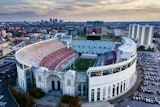Four in five health clubs now offer the services of personal trainers but few fully utilize them

Ten, or even five years ago, personal training would have seemed to be a tough sell for even the most marketing-conscious health clubs. Consider it from your customers' point of view: You already charge them a monthly membership fee, for which you promise a certain level of service. Then you offer to charge them more for a service that many of them might have assumed came with their membership. Thanks, but no thanks.
The toughest person to sell on personal training, though, might have been you. Consider: People come to work out on your equipment, run on your track, use your racquetball courts and so on, for which they write you a monthly check. Now you're going to allow a handful of trainers - who, after all, haven't made a single capital expenditure - to use your equipment, tie up your phones and complicate your accounting procedures, all for a split of their fee. If they draw a following, there's even the chance they'll eventually move elsewhere or start their own business and take your customers with them. Who needs those sorts of hassles?
Nagging questions persist, but personal training is flourishing. IDEA, the San Diego-based organization of health and fitness professionals, has about 8,000 personal trainers on its rolls, up from zero a little more than five years ago. In all, the group estimates there are now 55,000 personal trainers in the United States. A 1997 survey of member clubs by the International Health, Racquet and Sportsclub Association found that 83 percent now offer personal training services.
And yet, despite this proliferation of programs, most health and fitness professionals believe personal training is among the most underutilized and least well-understood aspects of the industry.
"The growth of personal training is so explosive that everyone's talking about it and trying to do it," says Gregory Florez of Chicago-based First Fitness Inc., "but there's not an under- standing yet of the personal trainer as a practitioner and deliverer of services, or the best ways for club owners to work successfully with them. Personal trainers add a ton of credibility to clubs, but owners have really not figured out how to capitalize on them."
"I have to agree," says Pat Ryan, editor of IDEA Personal Trainer. "Sometimes club owners struggle to know what to do with that department. Is it a customer service? Is it a profit center? Will it build other programs or not?"
Even clubs with successful personal-training programs buy into the underutilization theory. At Shula's Athletic Club in Miami, where memberships account for 80 percent of revenues, personal training is the second-highest revenue source, at 6 percent ($102,000 last year). But Bill Higgs, general manager of the 35,000-square-foot club, says they still have a ways to go.
"Each year we try to make greater and greater strides; this year, we committed more payroll dollars to the program," says Higgs. "So far it's paid off for us, but I don't think we've reached the limit of what we could do with personal training. We haven't perfected it by any means."
Personal training as a profession has certainly made strides. Trainers hold many more degrees, undergraduate and advanced, in relevant fields than ever before. There are at least half a dozen recognized certifications available to them. Their clients - and they no longer work exclusively with the rich or super-rich - expect more from them. A trainer's background might be in kinesiology, but clients will look to him or her for recommendations regarding nutrition and supplements, workout clothes and home exercise equipment.
And while most clients use a trainer for help in developing a strength and flexibility program (using free weights or selectorized machines), there is no such thing as a typical training regimen or format. There's still one-on-one training, of course, but there's also one-on-two (or more) training; treadmill training for anything from walking to marathons; sport-specific workouts for golf, skiing or tennis; rehabilitative training for injured athletes; and targeted programs for men or women, or for teens or mature adults.
Truly proactive clubs also use their personal trainers for outreach. Whether that means speaking to local women's groups about the benefits of women's strength training, to soccer parents about soccer-specific injuries, to golfers about how fitness programs relate to their performance or to senior citizens about the importance of staying fit, the personal trainer can offer clubs an alternative to pure marketing.
"It's pretty exciting," says Florez. "Personal training can be a lot of things to a lot of people, depending on your facility's goals and the demographics you're after."
Tempering the excitement somewhat is the difficulty of organizing and managing all that activity. A small number of club owners - even though they recognize the profit potential these programs represent - opt out of the management end of the personal training program, choosing instead to hire independent personal training businesses to operate within their clubs for a flat fee. This setup has a built-in drawback: Loss of control over the program. If club owners are going to use personal trainers to attract and retain members, they have to be able to bring them in line with their own goals and expectations.
But this is proving to be a dicey proposition even among the vast majority of clubs who hire their own trainers. Some owners view personal trainers' in-home businesses as a potential conflict of interest, while some trainers may feel undercompensated, given the amount of outreach and programming that may be expected of them.
"There does seem to be a lack of understanding between many owners and personal trainers," says Ryan. "Some trainers don't understand where the dollars go. They don't know why the owner wants to retain, for instance, 50 percent of their fee, and owners probably don't do a good job of explaining their overhead, the expenses they pay. So this hasn't been successful in all clubs."
Florez believes club owners haven't put enough thought into how they compensate trainers. "Owners don't always understand what constitutes a win-win relationship, specifically how they can give trainers incentives in a way that's meaningful and doesn't treat them like just another salesperson," he says. Calling trainers "a little bit more of an entrepreneurial sort by nature," Florez suggests "creating ways for them to be entrepreneurial" within the club setting. Since personal training helps clubs retain members, how about rewarding trainers with bonuses based on the longevity of their relationships with certain clients? Since personal trainers bring in new members as a result of their outreach efforts, how about offering a cut of each new membership resulting from a referral?
Florez's clients get an earful of this whenever he's around, but he's not the only one preaching it. The fact is, many club owners are picking up on the referral and retention possibilities and are therefore setting up their personal training programs as break-even propositions. Personal trainers in club settings generally keep 40 to 50 percent of their fee, but Ryan is noticing many more clubs giving their trainers 60 percent and even, in one case, 80 percent.
"Personal trainers tend to perceive that health clubs don't pay them as much as they could make on their own," Ryan says. "Owners increasingly have to give trainers, particularly if they're very good, a certain level of income in order to retain them."
So far at least, owners are losing the battle, at least if personal trainer turnover is the relevant measure. (It's currently higher than it's ever been.) Ryan says throwing money at the problem won't necessarily solve it, as compensation isn't the only way to keep a strong cadre of trainers. "Don't forget, there's also been a tremendous influx of people into the field who perhaps are excellent in exercise science and working with people, but who don't have business skills - nor do they want them. They need to work for somebody else; that's their niche," Ryan says. "The clubs I know of that are successful are the ones where, no matter what the level of compensation, personal trainers are really integrated into the rest of the club."
How to do that? One way is to throw out the compensation model altogether. At East Bank Club in Chicago, for example, the 40 personal trainers are full-time staff who are paid a salary, not a split of the $30, 45-minute fee. While Jan Slater, who runs the personal training program, won't divulge numbers, she says the club offers incentives based on the number of sessions worked, including the one free session offered to each new member. The club also offers a benefits package and professional stipends for continuing education.
Most clubs now offer members a free personal training session as an orientation, or what they call a "fitness evaluation." Shula's Athletic Club offers a free orientation and evaluation, and two free training sessions, and Higgs says they've found that even after that, many members will pay for 10 sessions (at $40 for a 45- to 50-minute session) just to keep their workout program at that same intensity level.
"Some members wing it, but others say, 'Well, I really haven't succeeded at getting myself fit in the last 10 years, so maybe I'm not so good on my own,' " Higgs says. "After a few sessions, they see the benefits and they've got a friend now who can help and encourage them."
Higgs's 12 personal trainers are all full employees, drawing a salary for their floor staffing duties (two are on the floor at all times), and receiving 50 to 55 percent of the fee charged, paid as sessions are completed even if clients pay for 10 sessions in advance. The club schedules the first appointments, but the trainers keep their own books.
The club has "played around with different incentives," Higgs says. "We've tried bonuses for this and that, all leading to the desired level of service that we want to project. Maybe it's the person who makes himself most available for orientations, who sold the most training sessions from an orientation, who had the most repeat clients, all those fun ways that motivate trainers and let them know we're supporting their efforts."
Service is also at the forefront of Sportset-Syosset's goals. The 42,000-square-foot Syosset, N.Y., club serves more women than men, and thus has on staff a large contingent of female trainers (currently one-third of the staff of 26). The club's training sessions average about $33 to $35 an hour - $89 for the four-hour "Trial Four" block of sessions - but increasingly are being sold by the half-hour, so more members can experience personal training. "We see it both as a revenue tool and as a retention device, so we try to get as many people involved as possible," says Brad McLam, the club's fitness director, although he notes a modest price increase is on the way. "Basically, we cover our costs and make a little money on it. We want to use it as something that's affordable to people, to keep them paying their memberships. We could probably get $50 an hour, but we'd cut the number of clients in half."
Sportset-Syosset gives members a free hour to set up their workout program, but management isn't big on free sessions. "It's perceived value," says McLam. "I've done promotions for free half-hours, free hours, but honestly once you put a price on something, people value it more."
In the early days of the program, McLam worried about a different perception taking hold among members - that trainers, who are paid a salary and about 35 to 55 percent of fees, would give their attention to their paying clients and ignore those "just" paying club memberships.
"Initially, we got a little criticism about the amount of service given personal training clients, and the lesser amount given other clients," McLam admits. "I've had to teach my trainers how to take care of members and clients at the same time in the proper manner. Obviously, you can alienate members if the staff isn't sensitive to everyone's needs. As fitness director, my job is to keep my staff sensitive to it and looking out for the club's interests first."
It is just such a circumstance that gives many club owners and managers pause about personal training. McLam, though, doesn't see any obstacle as being impossible to overcome.
"Most of my trainers have private businesses, and obviously, they could make more money on their own," he says. "Initially, we thought it'd be a conflict of interest. However, they use this as a supplement to their businesses, and we feel we understand what their needs are and that there's mutual respect. We have a non-solicitation agreement, which they sign, but there's just not an exodus of people leaving here because of trainers taking them out. Quite honestly, I'd know about it."
Understand that Florez is a cheerleader for personal trainers. He sees potential for personal trainers all over your club, starting with their "soft sales" role, their position as "the gatekeeper," "a huge conduit to influencing people" and "the general practitioner, in some cases, of all of health and fitness."
Many club owners may not see trainers' recommending types of home equipment to club members as benefiting the clubs, but Florez says more and more do. Those owners, he says, as do their trainers, see that "if they direct members to the right products and resources and give them the right information, that service makes them that much more irreplaceable." Club owners whose trainers are asked for equipment recommendations should put the club's resources behind their effort, Florez believes, perhaps even helping to sell home equipment.
"Personal training is a service that sells itself," says Florez. "But more than that, it helps sell adjunct services and products within the club. For example, if you've got a nutritionist or a dietician on staff, every member who works with the personal trainer should have at least one consultation with the nutritionist to help align everybody's goals. That gives the club a chance to show new members the value of the nutritionist's services."
Asked about clubs that are putting such concepts into action, Ryan nominates The Fitness Group, a club in Vancouver, B.C. Trainers there give lectures on exercise and clinics on cycling, walking and running half-marathons, for which they sometimes charge a small fee. They also participate in contests, such as "Cardio Blitz," where clients try to match trainers' benchmarks in various types of exercise, and the "Train the Trainer Auction," a charity event where clients bid for the opportunity to train the trainers.
"There are all these ways to raise the visibility of the personal trainer," Ryan says, "and that in turn brings exposure to the club, helping generate interest among members and the surrounding community."
None of this will do your club any good, of course, unless you've hired personal trainers who share your philosophy. But most industry observers see the risks easing as personal trainers' professionalism, body of knowledge and breadth of education continue to rise.
"Your floor staff is the key element in making sure clients get the results they want, continue coming to your club and hopefully recommend it to others," says Higgs. "The front desk is nice - we've all looked at how to be service-conscious there - but once you get past the desk, it's your fitness staff who spends the most time with each member. They can have the greatest impact on the success of your club. To me, clubs that don't want to mess with it are missing a high-end service opportunity."
As to the issue of who prospers, the trainers or the club, Higgs says it's not an either-or question.
"The people who get involved in personal training have a much closer tie to our club," he says. "The clients get better results, and the club gets a member who's that much more attached to the club and will keep coming. If I could talk 100 percent of the members into getting a personal trainer, that would be the ultimate scenario."




































